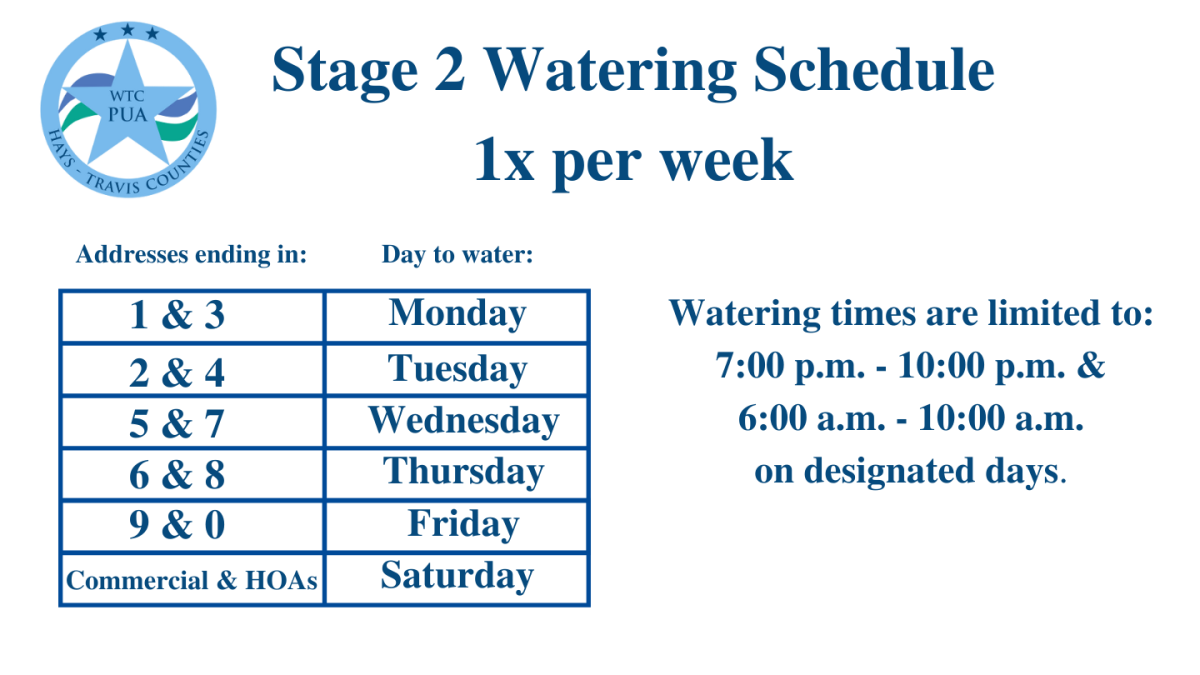As of May 1st, 2024, a new watering schedule is in place for WTCPUA customers. Mandated by the Lower Colorado River Authority (LCRA), irrigation will be limited to 1 time per week, according to the schedule below. The schedule is based on the last digit of the homeowner's address. This is according to our Stage 2 policy, which means there is only moderate water available and restrictions are necessary to ensure there is enough treated water for consumption.
Commonly Asked Questions:
1. Why were the times selected and why can't I water overnight? The times for watering are based on plant capacity. We are allowing evening hours and morning hours to give customers more flexibility. Having a break between 10:00 p.m. and 6:00 a.m. allows our tanks to recover. This time frame also allows customers to better monitor their irrigation systems and make sure there are no leaks causing even more water to be used.
2. Can I water by hand? Yes, you may water by hand or with a 5-gallon bucket at any time.
3. What happens if I irrigate outside of the schedule provided or irrigate more than I should?
1st offence: Warning letter
2nd offence: $500 fine
3rd offence: $1,000
4th offence: WTCPUA can disconnect water service after adequate notice to the customer and the customer must pay $500 reconnection fee
4. How do you enforce these restrictions? We do 60 hours a week of patrolling neighborhoods. Patrols are both random and based on complaints from people who live in the neighborhood.
5. What determines what stage we are in? LCRA determines the stage based on the the combined capacity of Lake Travis and Lake Buchanan. Additionally, WTCPUA may implement a stage outside of that based on the capacity of the treatment plant or other emergency conditions.
6. Why is irrigation in particular restricted? Irrigation uses up to 70 percent of our treated water supply. During a drought or in the hot summer months, use of treated water for irrigation increases even more, putting supply at risk for normal, everyday consumption.

Tips for Creating Drought Resistent Lawns
1. Water your lawn less: Watering your lawn less often and more deeply helps build grow strong roots that will capture and utilize the water more efficiently. If you have an automatic system, set it to the day allowed for your address and a time within the allowed period when there is no sun and temperatures are a bit cooler. This helps avoid evaporation and ensures the water being used has a chance to soak deeply into the ground.
2. Remove weeds: Weeds compete with your grass for soil and nutrients. Create a plan to remove your weeds so that your grass can stay healthy.
3. Raise Mowing Height: Mowing the grass too short in a drought can stress it and make it more susceptible to damage. To help your lawn cope better, increase the mowing height by at least 25 percent and minimize foot traffic on the grass. Remember to adhere to the 1/3 blade mow rule, particularly in hot weather conditions.
4. Plant Drought-Tolerant Grass: Drought-tolerant grass types such as Bermuda or Zoysia need less water compared to regular grass and can endure dry spells better. Keep in mind that many warm-season grasses may become dormant during severe conditions, such as extended droughts. During dormancy, grass appears brown, dry, and devoid of life. The blades lose their upright position and lie flat, creating a matted appearance, which is also common in dead grass. Dormant grass, though seemingly lifeless, is alive at its roots and crown and has the potential to bounce back. Dormancy serves as a physiological process that grasses employ to shield themselves from heat and drought.
5. Maintain a Healthy Soil: It is recommended to test your soil annually and adjust it as needed to maintain the correct nutrients, cation exchange, and the essential water, oxygen, and microbial activity for a healthy lawn. Having a vibrant lawn before summer heat or drought sets in is crucial for its resilience. A detailed soil test will provide guidance on necessary nutrients, aeration, and other requirements for your lawn.
6. Install an Efficient Irrigation System: Installing efficient irrigation systems can enhance water usage, ensuring your lawn receives the precise amount of moisture when needed, minimizing wastage. Contemplate the installation of a drip irrigation or smart sprinkler system that adapts watering schedules according to weather patterns and soil moisture levels. These innovative systems can prevent overwatering, directing water to the root zone for deep root development and a lush, healthy lawn.
7. Use Sustainable Lawn Care Practices: Opting for sustainable lawn care practices can greatly enhance your lawn's resilience to drought conditions. Here are some tips to consider:
- Leave grass clippings on the lawn after mowing to act as natural mulch and provide soil nutrients.
- Ensure clippings are evenly distributed and not more than ¼ inch thick.
- Avoid over-fertilization, as it can raise water needs and weaken the grass.
- Opt for a mix of fast and slow-release fertilizers to boost long-term soil health.
- Refrain from fertilizing during extreme temperatures to maintain your lawn's well-being.
7. Use Drought Resistant Plants: By using drought-tolerant plants, you can lower your lawn's water needs, decreasing your total water consumption. These plants are well-suited to survive in dry conditions and can endure extended drought periods. Think about including varieties such as sedum, yarrow, lavender, and native grasses that flourish in arid environments, bringing vibrant colors and textures to your outdoor space.
 Skip to main content
Skip to main content

